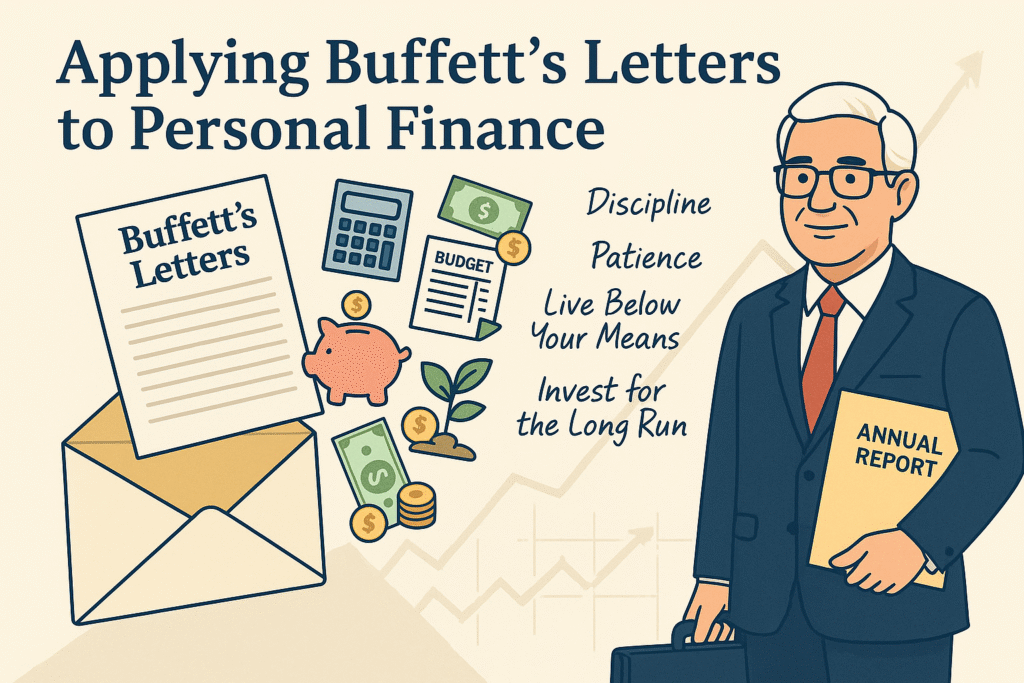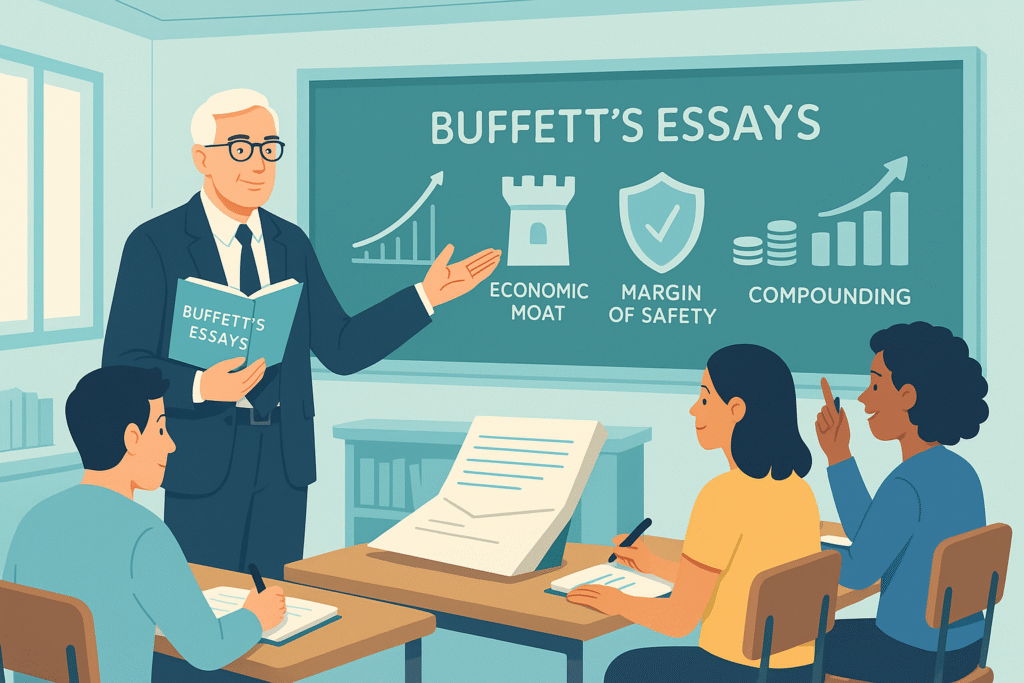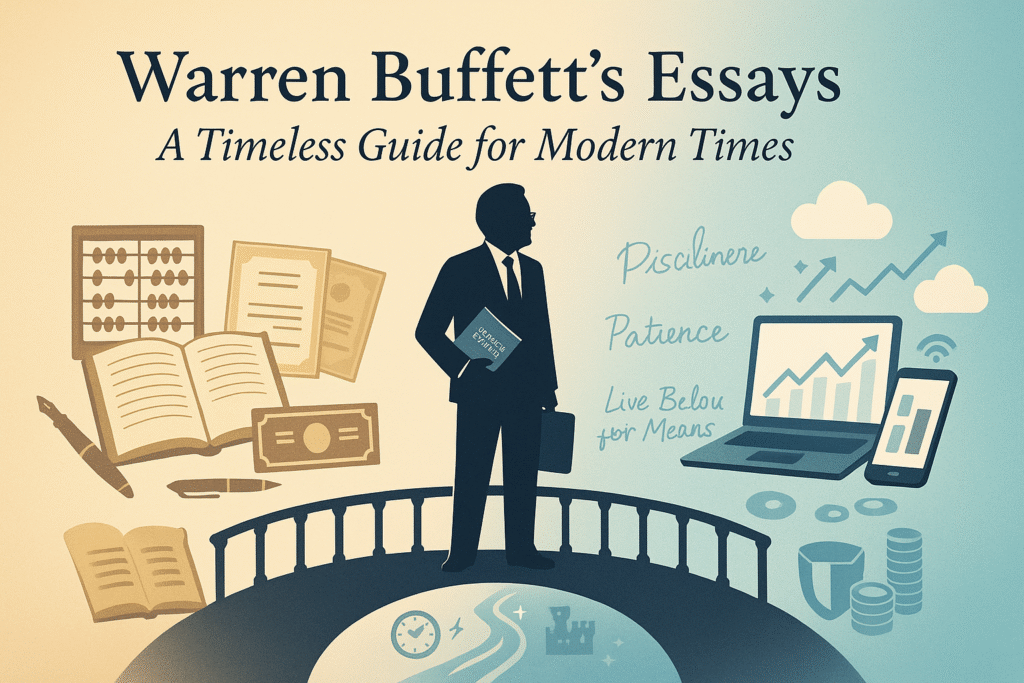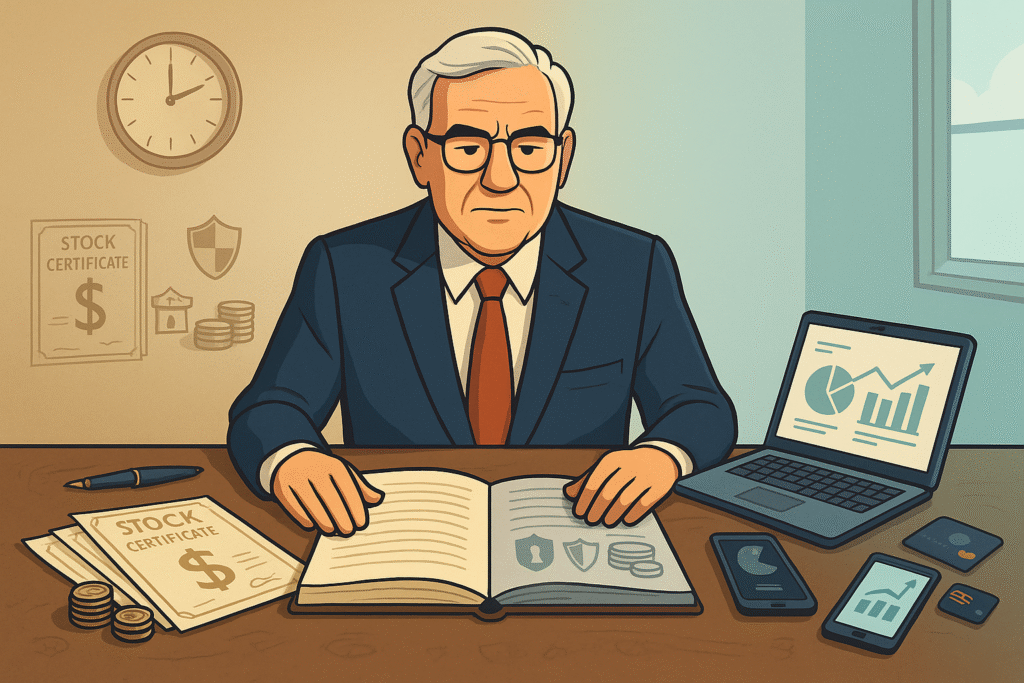Ever wonder why a 94-year-old investor’s musings from decades ago still get quoted more than your favorite Instagram influencer? Warren Buffett’s annual letters aren’t just financial reports—they’re masterclasses in clarity and wisdom that continue to influence investment strategies worldwide. Warren Buffett’s essay relevance isn’t just a nostalgic nod; it’s a testament to timeless principles that still move markets and shape minds.
Importantly, you don’t need to be managing billions to benefit from Buffett’s investment philosophy. His no-nonsense approach to value investing has helped countless people build wealth through market turbulence and economic shifts.
The Oracle of Omaha’s essays remain particularly relevant in today’s volatile market because they strip away complexity and focus on timeless principles. While financial trends come and go, Buffett’s emphasis on understanding business fundamentals never expires.
But there’s something curious about these letters that separates them from typical financial advice—something that explains why they’ve outlasted thousands of investing books and market predictions…
Timeless Investment Principles from Buffett’s Essays

Value Investing: Finding Underpriced Assets in Any Market
In 2025, with markets more volatile than ever, Buffett’s core value investing principles still cut through the noise. What makes his approach so powerful? He buys businesses, not stocks. While everyone else obsesses over quarterly earnings and price movements, Buffett focuses on the intrinsic value of companies.
“Price is what you pay, value is what you get,” Buffett wrote decades ago. This simple statement remains the backbone of smart investing today. Warren Buffett’s essay relevance is clear when you look at companies like Apple in 2016 or Bank of America in 2011—Buffett spotted value others missed, guided by principles he’s preached for years.
The beauty of value investing in today’s market? It works in any economic climate. During the tech boom of 2020-2023, value investors who stuck to their guns found overlooked companies trading at discounts while everyone chased the latest AI darlings. For more lessons from Warren Buffett’s latest insights, read this article on his annual Berkshire Hathaway letter here.
Want to apply this today? Look for:
- Companies with strong balance sheets
- Consistent cash flow
- Durable competitive advantages
- Management that allocates capital wisely
- Prices below intrinsic value
The Power of Long-Term Thinking in a Short-Term World
Scroll through any investing app and you’ll see the world has obsessed for quick wins. Day trading, options gambling, and chasing meme stocks dominate retail investing in 2025.
Meanwhile, Buffett’s perspective remains refreshingly contrarian: “The stock market is designed to transfer money from the active to the patient.”
Notably, his essays consistently hammer home this point: true wealth creation happens gradually, over decades—not days. Consider his Coca-Cola purchase in 1988—he’s still holding those shares 37 years later, with dividends now yielding over 50% annually on his original investment.
The long-term approach gives you three massive advantages:
- You save on transaction costs and taxes
- You benefit from compounding returns
- You avoid emotional decision-making during market panics
In a world of algorithmic trading and 24/7 market commentary, Buffett’s patience seems almost revolutionary.
Why “Circle of Competence” Matters More Than Ever
The explosion of investment options in 2025 makes Buffett’s “circle of competence” concept more crucial than ever. With thousands of stocks, cryptocurrencies, AI ventures, and biotech startups competing for your dollars, how do you decide? Warren Buffett’s essay relevance lies in cutting through the noise—reminding investors to stick to what they truly understand instead of chasing trends they can’t decode.
Buffett’s answer is disarmingly simple: stick to what you understand.
“Risk comes from not knowing what you’re doing,” he wrote. This isn’t about limiting yourself – it’s about being honest about what you know.
Look at Buffett’s portfolio – you won’t find complex derivatives or speculative tech plays. Instead, you’ll see consumer brands, insurance, and banking – businesses with understandable models and predictable cash flows.
The circle of competence isn’t static. You can expand it through deliberate study and experience. But expanding it slowly and methodically beats jumping into investments you don’t understand.
When you invest within your circle:
- You spot opportunities others miss
- You recognize problems earlier
- You make decisions based on knowledge, not hope
- You sleep better at night
How Buffett’s Margin of Safety Protects Modern Investors
Market crashes in 2008, 2020, and early 2024 reminded us all: investing carries risk. Buffett’s “margin of safety” principle provides a practical shield against uncertainty.
Fundamentally, the concept is brilliantly straightforward: only invest when the price is significantly below your calculation of intrinsic value. This built-in cushion provides protection against errors in your analysis and unexpected market shifts.
Think of it as building a bridge designed to hold 30,000 pounds when you only expect 10,000 pounds of traffic. That’s your safety margin. Warren Buffett’s essay relevance shines here—his consistent emphasis on margin of safety isn’t just theoretical; it’s a practical mindset that still anchors resilient investment strategies today.
In practice, this means:
- Avoiding investments that require perfect execution
- Being skeptical of rosy growth projections
- Demanding bigger discounts for businesses facing disruption
- Walking away when prices don’t offer sufficient margin
This principle saved Buffett during the dot-com bubble, the 2008 crisis, and the 2021-22 tech sell-off. While others bought at any price, his insistence on safety margins preserved capital.
The margin of safety isn’t exciting or glamorous. But in an investing world full of speculation and FOMO, it remains your best defense against permanent capital loss.
Buffett’s Business Wisdom for Today’s Economy

The Competitive Advantage Moat in the Digital Age
Warren Buffett’s concept of an economic moat remains eerily relevant in today’s digital landscape. But what does a moat look like when business happens at the speed of light?
The modern moat isn’t just about physical assets anymore. Look at companies like Apple – their ecosystem is practically a fortress. Once you’re in, you’re in. Try switching from iPhone to Android after years of app purchases and iCloud storage. That’s a moat built on switching costs that Buffett would admire.
Network effects have become the ultimate moat in our connected world. Facebook isn’t valuable because of its code (which could be replicated), but because everyone you know is already there. Each new user makes the platform more valuable – exactly the kind of self-reinforcing advantage Buffett seeks.
Data has emerged as another powerful moat. Companies like Google and Amazon have amassed treasure troves of user information that competitors simply can’t match overnight. This data advantage lets them deliver better services while making it nearly impossible for newcomers to catch up.
Buffett’s moat principle hasn’t changed—it’s just evolved. The businesses dominating today’s economy have found digital ways to create the same competitive advantages he’s always valued. Warren Buffett’s essay relevance is evident in how tech giants now build moats with data, ecosystems, and user loyalty instead of just factories and patents.
Management Quality: Identifying Today’s Skilled Leaders
Today, Buffett famously said he looks for “three things in a person: intelligence, energy, and integrity.” But identifying these core traits requires a different lens in 2025—one that filters through digital personas, remote work cultures, and rapidly evolving definitions of leadership.
Today’s exceptional leaders demonstrate adaptability above all else. The market moves faster than ever, and the ability to pivot without losing sight of core principles separates the good from the great. Satya Nadella’s transformation of Microsoft from a stagnating software giant to a cloud computing powerhouse exemplifies this perfectly.
Transparency has become non-negotiable. Leaders who communicate honestly about challenges build trust in ways that were optional decades ago. When Yvon Chouinard of Patagonia openly discusses the environmental impact of their products, it strengthens customer loyalty rather than weakening it.
Long-term thinking remains as rare and valuable as when Buffett first emphasized it. In a business world obsessed with quarterly results, leaders willing to sacrifice short-term gains for sustainable growth stand out dramatically.
The best executives today balance traditional leadership qualities with digital fluency. They understand technology’s implications without chasing every trend – exactly the kind of disciplined approach Buffett would recognize and appreciate.
Spotting Durable Business Models in a Rapidly Changing Landscape
The pace of disruption has accelerated dramatically since Buffett began investing, but his focus on durability remains spot-on. What makes a business model likely to endure today?
Recurring revenue has become gold. Subscription models create predictability that one-time purchases can’t match. Companies like Adobe transformed from selling boxed software to offering cloud subscriptions, creating steadier cash flows and deeper customer relationships – precisely the kind of predictability Buffett values.
Platform businesses that facilitate transactions between multiple parties (think Airbnb or Shopify) create value beyond their own direct offerings. These businesses become more entrenched as they grow, developing the kind of staying power Buffett seeks. Warren Buffett’s essay relevance surfaces here too—his emphasis on durable competitive advantages finds fresh expression in today’s platform-driven economy.
Businesses with genuine pricing power still stand the test of time. When customers are willing to pay premium prices because alternatives simply don’t compare, you’ve found a durable advantage. Apple’s ability to command higher prices than competitors proves this principle remains intact.
Additionally, flexibility matters more than ever. Companies with agile operating models that can quickly adapt to changing conditions—without requiring massive reinvestment—possess a resilience that would impress Buffett. Amazon’s expansion from books to everything imaginable demonstrates this adaptability.
The fundamentals Buffett identified decades ago still separate lasting businesses from shooting stars. The principles haven’t changed – only the context has.
Psychological Insights That Never Expire

Overcoming Market Fear and Greed in the Social Media Era
Warren Buffett famously said, “Be fearful when others are greedy, and greedy when others are fearful.” This advice hits differently in our social media-dominated world.
Imagine scrolling through Twitter during a market crash. Everyone’s panicking, posting charts pointing straight down, and declaring the end of the financial world. Your instinct? Sell everything before it gets worse.
That’s exactly when Buffett would be buying.
Social media amplifies market emotions to eleven. A single tweet from a billionaire can send a stock soaring or crashing within minutes. Financial influencers create FOMO with every bull run, making you feel like you’re missing out if you’re not all-in.
How do you stay grounded? Simple. Disconnect.
Not completely, but create space between market noise and your decisions. Try this:
- Set specific times to check financial news (not during market hours)
- Follow analysts with different viewpoints
- Keep a trading journal noting your emotional state with each decision
For example, when GameStop exploded in 2021, those who bought at the top weren’t thinking clearly—they were caught in a surge of social-driven mania rather than grounded analysis.
Buffett’s psychological insight wasn’t just about recognizing market emotions—it was about recognizing your own. In a world designed to hijack your attention and emotions, this skill matters more than ever. Warren Buffett’s essay relevance is striking here, reminding us that emotional discipline is as much a competitive edge as any financial model.
Contrarian Thinking: Why Going Against the Crowd Still Works
The crowd has never been louder than it is today. But that doesn’t make it right.
Buffett’s approach to contrarian thinking isn’t about being different for difference’s sake. It’s about seeing value where others don’t. When everyone rushed to tech stocks during the dot-com boom, Buffett stayed away. People called him outdated, behind the times.
Then the bubble burst.
Why does contrarian thinking still work in today’s sophisticated markets? Because human psychology hasn’t evolved. We still:
- Overreact to short-term news
- Flock to what’s popular
- Feel safer in a crowd
- Overvalue recent events
Take Bitcoin in late 2017. As prices approached $20,000, mainstream media coverage exploded. Your neighbor’s cousin was suddenly a crypto expert. That’s exactly when smart contrarians started taking profits.
The real skill isn’t just going against popular opinion – it’s understanding why the crowd thinks what it thinks, then asking the questions they’re not asking.
What costs are they ignoring?
What assumptions are they making?
What historical patterns are they forgetting?
Buffett’s essays remind us that true contrarian thinking requires both courage and deep analysis. You need to build a case strong enough to withstand not just market pressure, but the psychological pressure of standing alone. Warren Buffett’s essay relevance comes through in this call to intellectual independence—an evergreen trait in a market driven by herd mentality.
The Investor’s Mindset: Developing Patience in an Instant Gratification World
We live in the age of same-day delivery, streaming content, and instant payments. Waiting for anything feels outdated.
Yet Buffett’s longest-held investments span decades, not days.
The gap between our culture’s expectation for immediate results and the reality of how wealth actually builds couldn’t be wider. Compound interest – Buffett’s “eighth wonder of the world” – works silently and slowly, then suddenly all at once.
Furthermore, developing patience isn’t just about waiting—it’s about reframing your relationship with time. While day traders obsess over minute-by-minute charts, Buffett thinks in decades. This perspective shift changes everything about how you invest.
Think about Apple stock. If you checked its performance daily during 2008-2009, you might have panic-sold during the financial crisis. But if you checked annually for the past 20 years, you’d see one of the greatest wealth-creation stories ever.
How do you build this patience muscle?
- Start with smaller positions so emotions don’t overwhelm you
- Write down your investment thesis before buying
- Set calendar reminders to review quarterly, not daily
- Study business fundamentals, not just price movements
The strange paradox: developing patience actually saves time. You make fewer trades, pay less in taxes and fees, and spend less energy worrying about market fluctuations.
In Buffett’s view, the stock market is simply a mechanism for transferring wealth from the impatient to the patient. That principle hasn’t changed one bit. Warren Buffett’s essay relevance lies in how steadfast truths like this continue to ground investors in a world of instant gratification and short-term noise.
How to Build Conviction When Markets Turn Volatile
The market’s dropping 3% today. Your portfolio’s bleeding red. Your phone’s buzzing with notifications. Friends are texting asking if they should sell.
What do you do?
This is where conviction matters most – and where Buffett’s wisdom shines brightest.
Conviction isn’t blind faith. It’s evidence-based confidence in your analysis. Buffett doesn’t hold through downturns because he’s stubborn. He holds because his research gives him certainty about long-term value.
Building true conviction requires:
First, doing the work upfront. Buffett reads annual reports for hours daily. Before buying anything, know the business inside out. What problems does it solve? How durable is its competitive advantage? What could kill this company in 10 years?
Second, focusing on what you can control. You can’t control markets, but you can control your buying price, position sizing, and emotional responses.
Third, playing out worst-case scenarios before they happen. Buffett mentally prepares for 50% drops because they’re normal in market cycles. When everyone else is shocked, he’s calm.
Volatile markets don’t break strong investments – they reveal weak ones. When a stock you own drops 30%, you’ll discover quickly whether your conviction was real or imagined.
Ultimately, the true test? Being able to articulate why you own something in clear, straightforward terms. As Buffett says, “If you can’t explain it to a six-year-old, you don’t understand it yourself.”
Applying Buffett’s Letters to Personal Finance

A. Living Below Your Means: The Foundation of Wealth Building
Warren Buffett still drives the same car he bought years ago and lives in the same house he purchased in 1958 for $31,500.
That’s not because he can’t afford better. It’s because he understands something most people miss: wealth isn’t about what you spend—it’s about what you don’t. Warren Buffett’s essay relevance echoes in this ethos of restraint, where discipline and humility often yield the greatest returns.
In his 1990 letter, Buffett wrote: “The most important thing to do if you find yourself in a hole is to stop digging.” This simple advice remains gold in today’s credit-card-happy world.
Look at these numbers:
- Average American savings rate: 4.7%
- Warren Buffett’s estimated savings rate: Over 90%
Buffett’s approach isn’t about miserly living. It’s about intentional spending. He famously said, “Don’t save what’s left after spending; spend what’s left after saving.”
This principle hits differently in 2025, when subscription services drain our accounts without us noticing. Every $14.99 monthly subscription equals $179.88 yearly—money that could be compounding instead.
Try this Buffett-inspired approach: Before buying anything over $100, wait 48 hours. You’ll be shocked how many “must-haves” become “maybe laters.”
B. Compound Interest: Your Most Powerful Financial Tool
Buffett calls compound interest the “eighth wonder of the world.” And he’s built his entire fortune on this simple concept.
Here’s why it matters: Buffett didn’t become a billionaire until he was 56. That’s right—the greatest investor of all time needed decades of compounding to build serious wealth.
In his 1991 shareholder letter, Buffett explained that Berkshire’s goal was to increase intrinsic value by 15% annually. That doesn’t sound impressive until you run the math:
| Years | $10,000 at 7% | $10,000 at 15% |
|---|---|---|
| 10 | $19,672 | $40,456 |
| 20 | $38,697 | $163,665 |
| 30 | $76,123 | $662,118 |
Consequently, the difference is staggering. Even modest gains in performance can generate massive wealth disparities over time.
Here’s the brutal truth: most people understand compound interest mathematically but fail to grasp it emotionally. That’s why we prioritize immediate gratification over future wealth. Warren Buffett’s essay relevance hits hardest here—his steady drumbeat on patience and compounding is less about numbers and more about mindset.
Buffett’s genius isn’t just earning good returns—it’s having the patience to let those returns compound decade after decade.
C. Why Simple Beats Complex in Investment Strategies
Buffett doesn’t use complex algorithms or high-frequency trading. His investment strategy is so simple it almost seems boring.
“If you’re not willing to own a stock for 10 years, don’t even think about owning it for 10 minutes,” he wrote in his 1996 letter.
While today’s financial world pushes complicated products, Buffett sticks to businesses he understands. He avoids tech stocks he can’t evaluate and focuses on companies with clear business models.
The results speak volumes:
| Strategy | Annual Return | Complexity Level |
|---|---|---|
| Berkshire Hathaway (1965-2025) | ~20% | Low |
| Average Hedge Fund (2000-2025) | ~7.5% | Very High |
Remember when crypto advocates called Buffett “out of touch” for avoiding digital currencies? When the markets crashed in 2022, his approach suddenly looked genius again.
Simple investing works because:
- Lower fees mean more money stays invested
- Fewer decisions mean fewer mistakes
- Understandable investments prevent panic selling
The next time someone tries to sell you on a complicated investment scheme, channel your inner Buffett and ask: “Do I really understand how this makes money?”
D. Buffett’s Tax Insights for Today’s Investors
Buffett raised eyebrows when he revealed he paid a lower tax rate than his secretary. This wasn’t tax evasion—it was understanding how tax law works.
In his 2012 letter, Buffett wrote about tax-efficiency: “I have paid all the income taxes I owe—but I have paid not one cent more.” Warren Buffett’s essay relevance is on full display here—spotlighting a shrewd, principle-driven approach to personal finance that still resonates in today’s complex tax landscape.
Here’s how to apply his tax wisdom in 2025:
First, prioritize tax-advantaged accounts. Buffett’s approach to minimizing drag on returns means maxing out your 401(k), IRA, or HSA before investing elsewhere.
Secondly, understand how capital gains work. Buffett rarely sells his winners, allowing deferred profits to compound untaxed. When you sell investments after holding them just 11 months instead of 12, you might be giving Uncle Sam an unnecessary bonus.
Third, consider location efficiency. Buffett places tax-inefficient investments in tax-advantaged accounts and tax-efficient investments in taxable accounts.
This isn’t about avoiding taxes—Buffett actually advocates for higher taxes on the wealthy. It’s about not paying more than necessary under current law.
The real-world impact? Someone earning $100,000 could save over $3,000 annually by applying these principles.
E. Avoiding Wealth-Destroying Behaviors in the Modern Economy
Buffett has a special talent for identifying behaviors that destroy wealth. And honestly, these pitfalls have only gotten worse since he first wrote about them.
“The most important quality for an investor is temperament, not intellect,” he wrote in his 2013 letter.
Today’s digital economy creates wealth-destroying temptations Buffett never faced:
- Trading apps with confetti animations when you make a transaction
- “Buy now, pay later” options at every checkout
- Social media influencers pushing get-rich-quick schemes
Buffett’s antidote? Cultivate patience and ignore market noise.
During the 2008 financial crisis, Buffett invested heavily while others panicked. In his letter that year, he wrote: “Be fearful when others are greedy, and greedy when others are fearful.”
Apply this thinking to today’s market fluctuations. When headlines scream about market crashes, most people sell at the bottom. Buffett sees these moments as opportunities.
The greatest threat to your wealth isn’t market volatility—it’s your reaction to market volatility.
Try this exercise: Calculate how much money you’d have if you’d invested $1,000 monthly in an S&P 500 index fund for the past 10 years… then compare it to your actual investment results. The difference is usually the cost of emotional decision-making. Warren Buffett’s essay relevance surfaces here as a quiet challenge—stick to fundamentals, tune out the noise, and let discipline do the compounding.
Buffett’s Essays as Educational Tools

How to Learn Investing Without an MBA
You know what’s bonkers? Wall Street wants you to believe you need expensive degrees to understand investing. Warren Buffett disagrees completely.
In contrast, Buffett’s essays—particularly his annual letters to Berkshire Hathaway shareholders—deliver a practical masterclass in investing that costs nothing but your time. While business schools teach theoretical models, Buffett teaches through actual decisions with real money on the line.
Take his 1989 letter where he breaks down the purchase of See’s Candies. In just a few pages, he covers brand value, pricing power, and return on capital better than most textbooks. And he does it without the confusing jargon.
Many successful investors credit these essays with forming their investment philosophy. The beauty is that Buffett writes for his sister, not for finance professors. He assumes you’re smart but not specialized.
Using Buffett’s Case Studies to Analyze Today’s Companies
Buffett’s essays are packed with detailed breakdowns of companies he’s purchased or passed on. These case studies become templates you can apply to modern businesses. For a comprehensive summary of key insights from Buffett’s latest annual letter, explore this detailed analysis here.
His 1987 analysis of newspaper monopolies might seem outdated, but the core lessons about moats and competitive advantages apply perfectly to today’s tech giants. When Buffett explains why he values GEICO’s low-cost advantage, you can use the same framework to evaluate companies like Costco or Amazon. Warren Buffett’s essay relevance lies in these transferable mental models—timeless tools for decoding ever-evolving markets.
What makes these case studies so valuable is how Buffett separates business performance from stock performance. He shows you how to:
| Buffett’s Framework | Modern Application |
|---|---|
| Identify consistent earning power | Evaluate subscription businesses |
| Assess management capital allocation | Analyze share buyback programs |
| Calculate intrinsic value | Determine fair prices for growth stocks |
The Art of Clear Financial Thinking in a Complex World
The financial world loves complexity. Complex products. Complex strategies. Complex explanations.
Buffett’s genius lies in his ruthless simplicity.
His essays demonstrate how to cut through the noise and focus on fundamentals. In his 1993 letter, he warns about derivatives being “financial weapons of mass destruction” – years before the 2008 crisis proved him right.
Interestingly, what’s remarkable is how Buffett takes complex topics and makes them accessible through analogies and stories. When explaining market volatility, he gives us “Mr. Market,” a wildly emotional neighbor who offers to buy or sell your business at erratic, unpredictable prices each day.
This clarity of thought transfers to readers. After spending time with Buffett’s essays, you start recognizing financial nonsense faster. You develop an immunity to fads and FOMO investing. You learn to ask simple questions that often have no good answers—which is exactly the point. Warren Buffett’s essay relevance is reflected in this mindset shift: a quiet revolution in how you think, not just what you know.
Why Reading Buffett Chronologically Reveals Market Patterns
Many people read random Buffett essays or quotes. That’s fine, but there’s magic in reading them in order from the 1960s through today.
By tracking his thoughts across decades, you witness how different market environments affect businesses and investor psychology. You see Buffett navigate the high inflation of the 1970s, the bull market of the 1980s, the tech bubble of the late 1990s, and the financial crisis of 2008.
What emerges is a pattern of human behavior that repeats with new packaging. The 1999 internet bubble looks remarkably similar to the 2021 meme stock mania when you strip away the specifics.
Buffett’s consistent principles standing against these changing backdrops teaches you something profound: markets change, technology changes, but human nature doesn’t. Fear, greed, and the tendency to follow crowds remain constant.
Reading chronologically also reveals Buffett’s evolution. You see how he moved from Benjamin Graham’s strict value principles to Charlie Munger’s “wonderful company at a fair price” approach – a journey that might mirror your own investing growth. For a detailed look at Buffett’s annual shareholder letters and key takeaways, check out this insightful resource here.
Conclusion

Warren Buffett’s Essays: A Timeless Guide for Modern Times
Warren Buffett’s essays continue to serve as a north star for investors, business leaders, and individuals alike. Moreover, from his timeless investment principles that emphasize value over speculation to his business wisdom that highlights the importance of competitive moats and ethical leadership, Buffett’s writings transcend market cycles and economic trends. His psychological insights about fear, greed, and patience provide readers with tools to navigate not just financial markets, but life’s challenges as well. For those looking to dive deeper, Warren Buffett’s letters to shareholders from 1965 to 2014 are available for purchase at this link, offering a treasure trove of wisdom straight from the Oracle of Omaha himself.
Whether you’re managing a portfolio, running a business, or simply trying to make sound financial decisions, Buffett’s essays offer practical guidance that remains as relevant today as when they were written. By incorporating these lessons into your approach and sharing them with others, you join a community of thoughtful, long-term thinkers who understand that successful investing—and successful living—isn’t about quick wins, but about making smart, principled decisions over time. Warren Buffett’s essay relevance isn’t just historical—it’s compounding in value, just like the principles he champions. The Oracle of Omaha’s words may have been penned decades ago, but their wisdom resonates louder with each passing year. Knowledge compounds too. Keep learning on the Investillect blog.

